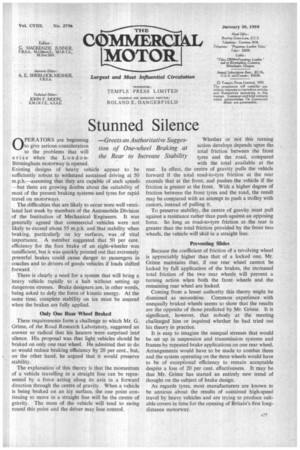Stunned Silence
Page 27

If you've noticed an error in this article please click here to report it so we can fix it.
OPERATORS are beginning to give serious consideration to the problems that will arise when the LondonBirmingham motorway is opened. Existing designs of heavy vehicle appear to be sufficiently robust to withstand sustained driving at 50 m.p.h.—assuming that they are capable of such speeds —but there are growing doubts about the suitability of most of the present braking systems and tyres for rapid travel on motorways.
The difficulties that are likely to occur were well ventilated last week by members of the Automobile Division of the Institution of Mechanical Engineers. It was generally agreed that commercial vehicles were notlikely to exceed about 55 m.p.h. and that stability when braking, particularly on icy surfaces, was . of vital importance. A member suggested that 50 per cent. efficiency for the foot brake of an eight-wheeler was insufficient, but it was quickly pointed out that extremely powerful brakes could cause danger to passengers in coaches and to drivers of goods vehicles if loads shifted forward.
There is clearly a need for a system that will bring a • heavy vehicle rapidly to a halt without setting up dangerous stresses. Brake designers are, in other words, being asked to defy the force of kinetic energy. At the same time, complete stability on ice must be assured when the brakes are fully applied, Only One Rear Wheel Braked These requirements form a challenge to which Mr. G. Grime, of the Road Research Laboratory, suggested an answer so radical that his hearers were surprised inte, silence. His proposal was that light vehicles should be braked on only one rear wheel. He admitted that to do so would reduce braking efficiency by 20 per cent., but, on the other hand, he argued that it would preserve stability.
The explanation of this theory is that the momentum of a vehicle travelling in a straight line can be represented by a force acting along its axis in a forward direction through the centre of gravity. When a vehicle is being braked on an icy surface, the one point continuing to move in a straight line will be the centre of gravity. The mass of the vehicle will tend to swing round this point and the driver may lose control. • Whether Or not this turning action develops depends upon the total friction between the front tyres and the road, compared with the total available at the rear. In effect, the centre of gravity pulls the vehicle forward if the total road-to-tyre friction at the rear exceeds that at the front, and pushes the vehicle if the friction is greater at the front. With a higher degree of friction between the front tyres and the road, the result may be compared with an attempt to push a trolley with castors, instead of pulling it.
To preserve stability, the centre of gravity must pull against a resistance rather than push against an opposing force. So long as road-to-tyre friction at the rear is greater than the total friction provided by the front two wheels, the vehicle will skid in a straight line. • Preventing Slides Because the coefficient of friction of a revolving wheel is appreciably higher than that of a locked one, Mr. Grime maintains that, if one rear wheel cannot be locked by full application of the brakes, the increased total friction of the two rear wheels will prevent a turning action when both the front wheels and the remaining rear wheel are locked.
Coming from a lesser authority this theory might be dismissed as moonshine. Common experience with unequally braked wheels seems to show that the results are the opposite of those predicted by Mr. Grime. It is significant, however, that nobody at the meeting challenged him or inquired whether he had tried out his theory in practice.
It is easy to imagine the unequal stresses that would be set up in suspension and transmission systems and frames by repeated brake applications on one rear wheel. Arrangements would have to be made to combat them and the system operating on the three wheels would have to be of exceptional efficiency to remain acceptable despite a loss of 20 per cent. effectiveness. It may be that Mr. Grime has started an entirely new trend of thought on the subject of brake design.
As regards tyres, most manufacturers are known to be anxious about the results of sustained high-speed travel by heavy vehicles and are trying to produce suitable covers in time for the opening of Britain's first longdistance motorway.




























































































